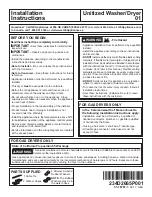
How to sort the clothes
Sort by surface
Separate
from
LINT PRODUCERS— Such as
terry toweling and chenille—give
up lint.
LINT
such as
man-made fibers and napped
fabrics like velveteen and corduroy
—attract lint. These must be
washed separately.
For more information on lint
control, see page 20.
Sort by fabric
Separate
from
from
from
In addition to sorting to reduce lint
collection, it is recommended that
fabrics of similar construction be
washed together whenever possible.
Sort by soil
Separate
from
from
Sort by color
Separate
Whites
from
.
Lights
from
from
.
t
Non-
Colorfast
FOR INSTRUCTIONS ON
DIFFERENT FABRICS AND
LOADS, SEE PAGES 6 and 7.
11
It pays to check and prepare
clothes for washing.
●
Empty pockets, brush out cuffs,
zip zippers, snap snaps, hooks
and buttons.
●
Do any necessary mending—rips,
hems, tears.
Check all items for areas of heavy
soil or stain.
●
Remove stains. For STAIN
REMOVAL GUIDE, SEE PAGE 19.
Turn
Knits inside-out to
minimize fabric surface damage.
Special Modern Fabrics Cycle for
removable heavy and oily soils.
(See
page 5 for instructions on
SUPERCYCLE operations.)
Soaking and
a good way to loosen deep soils
and stains.
A thorough soaking with detergent
or special soaking agent is another
way to remove heavy soils,
embedded dirt and even some
stains.
Soaking can be either a completely
separate washing step or a prelim-
inary step to a complete wash cycle.
For detailed information on how
to soak in your washer, see page 8.
FOR INFORMATION ON
AGENTS, SEE
PAGE 17.
.
heavy soil by rubbing in
a small amount of liquid detergent
paste made of water and powdered
detergent or soap. For best results,
wait 1/2 hour before washing.
I












































